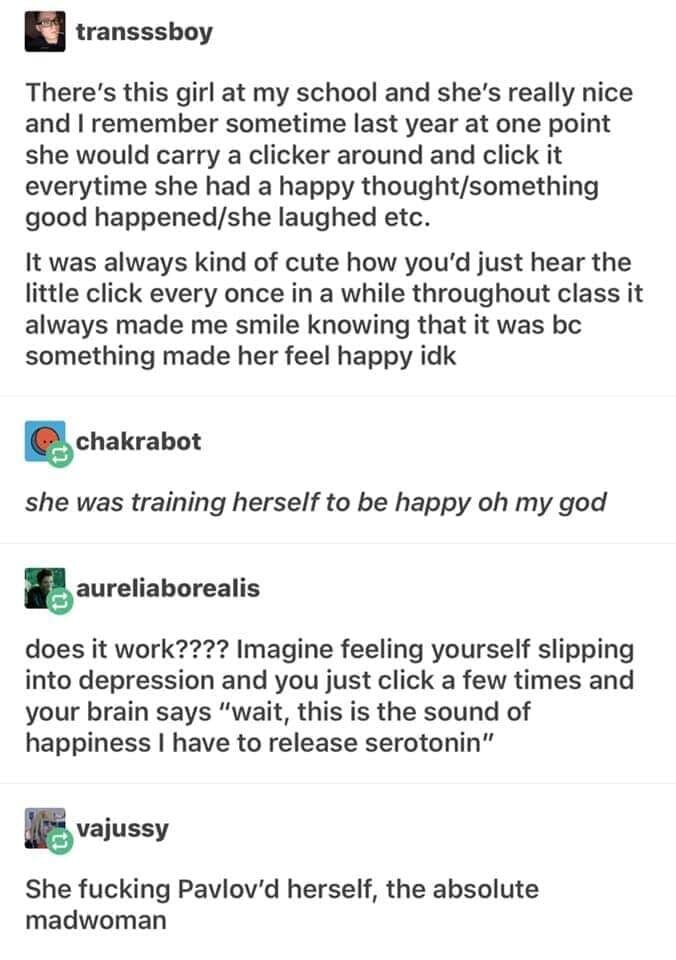90 Days of Tally Clicking Anxiety
INTRODUCTION
Optimistic people are better.
They have fewer heart issues, live longer, experience less post-operative pain, heal faster, and have been linked with better athletic performance. Meanwhile, pessimism and anxiety have been connected with chronic inflammation, depression, and can even cause people to misread social cues.
As a pessimistic and anxiety-ridden person - that is, one who expects negative future outcomes - the mystical, perhaps not as well researched, studies heralding optimism as a panacea to all ills do not interest me. I just feel immense stress and panic constantly and want it to end. But other than vague remonstrations to “stay upbeat” or “exercise more” there isn’t really a robust system to change mindset. Furthermore, psychological tests to determine a person’s level of optimism and pessimism are vague, relying on memory, feeling, and generalities.
Over the last 90 days I’ve noted the number of discrete, moment-to-moment instances of anxiety I’ve experienced using a simple hand tally counter. After each day I recorded the number in order to obtain a more accurate metric. I’ve written about this here:
Glass Half Full: 90 Days of Tally Clicking Pessimism to Optimism
Glass Half Full Day 16: The Thanksgiving Blues
Glass Half Full Day 25: Mythology
Glass Half Full Day 85: Under Pressure
As with other vices, my “tally clicking” system simultaneously diminishes mental habits, charting the change across time. I also took a battery of more traditional psychological tests for various facets of mindset to provide a before and after snapshot.
DATA
Before and after tests:
Revised Life Orientation Test (LOT-R): 1/40 (Before), 20/40 (After)
Optimism/Pessimism Test (SeeMyPersonality.com): 100 % Pessimist (Before), 50% Pessimist (After)
Subjective Happiness Scale (SHS): 1.75/7 Happy (Before), 3/7 Happy (After)
Oxford Happiness Scale: 2.27/6 Happy (Before - Not happy/Somewhat Happy), 4.52 (Moderately Happy/Average person)
Mental Fatigue Scale (MFS): 16.5/40 (Before), 8.5/40 (After)
DID IT WORK?
Yes and no.
As the graph and the tests indicate, the changes were massive.
Incidences of anxiety decreased, and most of the anxiety/cynicism/optimism scales changed positively by 50%. In addition, my mental fatigue got significantly better, confirming my suspicion that this would affect other mental processes.
But in the few days after the challenge some of the anxiety returned, leading me to conclude that for a large scale, permanent change this is just the beginning – but a very good beginning.
PATTERNS
Throughout the challenge I noticed certain patterns to my anxiety. I tend to get nervous in the morning and at night. I also noted different vectors of emotion:
Depression - which seemed to be past facing and tends to get better with gratitude.
Jealousy - a present facing, comparison-based phenomenon that gets better with compassion.
Anxiety/optimism/cynicism - future facing, improving with reframes .
Other vectors, like energy and happiness
CHANGING THE CHALLENGE
The project started with simply tallying and recording all instances of anxiety during the day. Early on I added a simple mental reframe - “what if it all goes perfectly?” - after every click. Halfway through the project I added another action - cherry picking evidence of the past where things in that situation went well. Unfortunately I wasn’t as diligent when I did this.
PROGRESSION
The pattern to this in terms of the graph was pretty similar to other instances of tally clicking (alcohol, food, beer) . And the internal feelings progressed similarly. It first started with a weird sensation of reordering in the mind. I began to catch a precursor to anxiety and counter it. My mind then focused on imaginary situations - whether just pure fantasy or dream scenarios – where vices or anxiety would pop up. Spontaneous optimism popped up significantly more throughout the day.
One unforeseen benefit was how it affected other people. I found myself automatically verbalizing positive positioning on events. I was also able to help out people and influence their thinking in many stressful instances.
WHAT DIDN’T WORK
I did not click general, formless anxiety (like being stymied in life or work), nor did I click very minute instances like the ones that cause me to tap my fingers or pick at my lip. Predictably, those did not diminish during the course of the challenge. It was also sometimes difficult differentiating between concern over outcomes in order to adequately plan versus becoming consumed with irrational fear over negative outcomes.
CONCLUSION
I think I’m on the right path.
As a diagnostic and metric tool, this method is far superior to the standbys. There is a visual map of day-to-day improvement that is clear and not as reliant on generalities as the normal psychological tests. It also provides tools for changing mindset in the moment, something that can’t be stressed enough.
But I believe this challenge needs to be taken further to become totally ingrained. It confirmed my early suspicion that removing anxiety is only a part of the equation. One also has to add positivity. I believe the best way to do this is just regular click training. And I intend to do another 90 day challenge to do just that.


